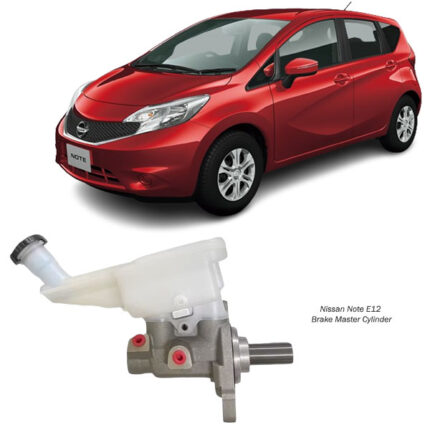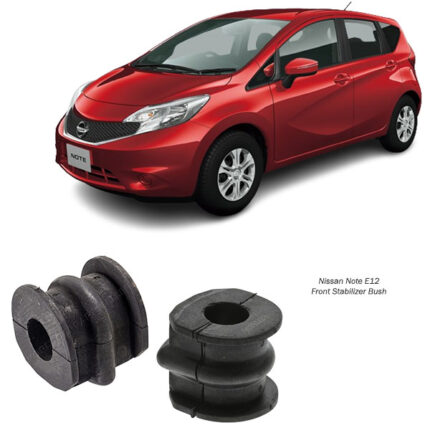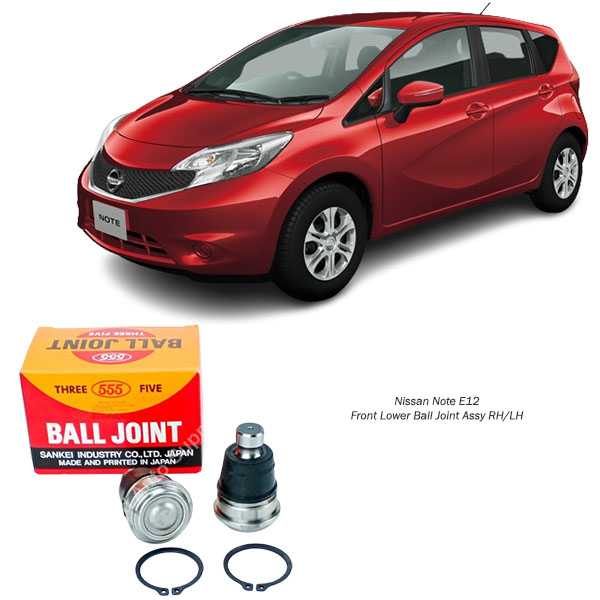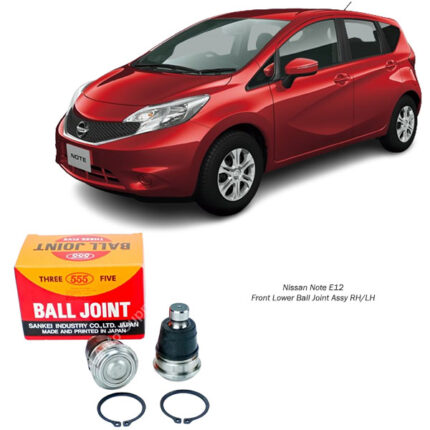Get Nissan Note E12 Front Lower Ball Joint Assy RH/LH SB-N332 in Kenya
The front lower ball joint assembly in the Nissan Note E12 plays a critical role in the vehicle’s steering and suspension system. It acts as a pivot between the control arms and the steering knuckle, allowing smooth movement of the front wheels while maintaining stability and control.
Without a properly functioning ball joint, steering becomes loose, tire wear increases, and handling deteriorates—potentially leading to dangerous driving conditions.
By the end of this guide, you’ll have a full understanding of front lower ball joints and how to maintain them for a safe and smooth ride. Let’s get started!
1. What Is a Front Lower Ball Joint?
The front lower ball joint is a spherical bearing that connects the control arm to the steering knuckle. It allows the wheels to move up and down (suspension movement) and left and right (steering movement) simultaneously.
1.1 Role of the Front Lower Ball Joint
Acts as a pivot point for the front suspension.
Allows vertical movement (for shock absorption).
Enables rotational movement (for steering).
Helps maintain alignment and stability.
Fun Fact: Ball joints work similarly to a human shoulder joint, providing flexibility and movement in multiple directions!
2. Types of Ball Joints Used in the Nissan Note E12
The Nissan Note E12 uses sealed ball joints for durability and low maintenance.
2.1 Sealed Ball Joints
- Factory-installed type with a permanent lubricant.
- No need for greasing or maintenance.
- Lasts longer but must be replaced as a unit when worn.
2.2 Greasable Ball Joints
- Some aftermarket options come with grease fittings.
- Requires regular lubrication to prevent wear.
- Can last longer if properly maintained.
Tip: If replacing your ball joints, consider high-quality aftermarket brands that offer greaseable versions for extended lifespan.
3. Symptoms of a Failing Front Lower Ball Joint
A worn-out ball joint can lead to serious issues. Here are the warning signs:
3.1 Clunking or Knocking Noises
- Loud metallic clunking when driving over bumps.
- Knocking sounds when turning or braking.
3.2 Loose or Unstable Steering
- Steering feels vague or less responsive.
- The vehicle drifts or wanders on the road.
3.3 Uneven or Excessive Tire Wear
- Inside or outside edges of the tires wear out faster.
- Cupping (irregular wear patterns) on the front tires.
3.4 Vibrations in the Steering Wheel
- Noticeable vibration when driving at high speeds.
- Worsens when turning or braking.
3.5 Excessive Play in the Wheel
- When lifted, the wheel moves excessively when shaken by hand.
- Indicates a loose or failing ball joint.
Warning: Ignoring a bad ball joint can lead to sudden suspension failure, causing the wheel to detach while driving!
4. Causes of Ball Joint Failure
4.1 Normal Wear & Tear
- Ball joints wear out over time due to constant movement.
4.2 Dirt & Contamination
- Dust, water, and road debris can enter a damaged seal, leading to rust and wear.
4.3 Rough Road Conditions
- Driving over potholes, speed bumps, or uneven terrain accelerates wear.
4.4 Overloading the Vehicle
- Carrying heavy loads puts extra stress on the suspension components.
4.5 Lack of Lubrication
- In greasable ball joints, failure to lubricate leads to increased friction and wear.
Tip: If you frequently drive on rough roads, inspect your ball joints every 20,000 km for early signs of wear.
5. How to Replace the Front Lower Ball Joint on a Nissan Note E12
Replacing a ball joint is a challenging job that requires special tools. If you’re not experienced, it’s best to take your car to a mechanic.
5.1 Tools Required
Jack & jack stands
Lug wrench
Ball joint press tool
Socket set & breaker bar
Torque wrench
New ball joint (OEM recommended)
5.2 Step-by-Step Guide
Loosen the lug nuts before lifting the vehicle.
Jack up the front of the car and secure it with jack stands.
Remove the front wheel.
Detach the lower control arm from the ball joint.
Use a ball joint press tool to remove the old joint.
Install the new ball joint, securing it with the press tool.
Reassemble everything and torque all bolts to spec.
Test drive to check for noise or handling issues.
Warning: Avoid using a hammer to install a ball joint—it can damage the component and misalign the suspension!
6. Maintenance Tips for a Long-Lasting Ball Joint
Inspect ball joints every 20,000 km or during routine servicing.
Listen for unusual noises when driving over bumps.
Avoid driving through deep water or mud, which can contaminate the joints.
Get regular wheel alignments to reduce stress on suspension parts.
Choose high-quality OEM or aftermarket ball joints for durability.
By following these tips, you can extend the life of your ball joints and ensure a smooth ride.
Follow us on Facebook for more parts.





Reviews
Clear filtersThere are no reviews yet.